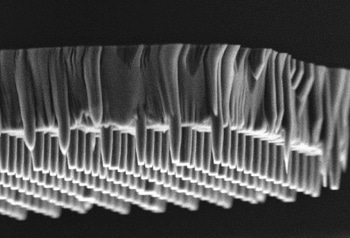May 3 2016
If using a single atom to capture high-resolution images of nanoscale material sounds like science fiction, think again.
 Scanning electron microscope image of a typical diamond cantilever fabricated for magnetometry.
Scanning electron microscope image of a typical diamond cantilever fabricated for magnetometry.
That’s exactly what the Quantum Sensing and Imaging Group at UC Santa Barbara has achieved. Members of physicist Ania Jayich’s lab worked for two years to develop a radically new sensor technology capable of nanometer-scale spatial resolution and exquisite sensitivity. Their findings appear in the journal Nature Nanotechnology.
“This is the first tool of its kind,” said Jayich, UCSB’s Bruker Endowed Chair in Science and Engineering and associate director of the campus’s Materials Research Lab. “It operates from room temperature down to low temperatures where a lot of interesting physics happens. When thermal energy is low enough, the effects of electron interactions, for instance, become observable, leading to new phases of matter. And we can now probe these with unprecedented spatial resolution.”
Under the microscope, the unique single-spin quantum sensor resembles a toothbrush. Each “bristle” contains a single, solid nanofabricated diamond crystal with a special defect, a nitrogen-vacancy (NV) center, located at the tip. Two adjacent atoms are missing in the diamond’s carbon lattice, and one space has been filled with a nitrogen atom, allowing for the sensing of specific material properties, particularly magnetism. These sensors were manufactured in the clean room of UCSB’s Nanofabrication Facility.
The team chose to image a relatively well-studied superconducting material containing magnetic structures called vortices — localized regions of magnetic flux. With their instrument, the researchers were able to image individual vortices.
“Our tool is a quantum sensor because it relies on the bizarreness of quantum mechanics,” Jayich explained. “We put the NV defect into a quantum superposition where it can be one state or another — we don’t know — and then we let the system evolve in the presence of a field and measure it. This superposition uncertainty is what allows that measurement to occur.”
Such quantum behavior is often associated with low-temperature environments. However, the group’s specialized quantum instrument operates at room temperature and all the way down to 6 Kelvin (almost minus 450° Fahrenheit), making it very versatile, unique and capable of studying various phases of matter and the associated phase transitions.
“A lot of other microscopy tools don’t have that temperature range,” Jayich explained. “Further highlights of our tool are its excellent spatial resolution, afforded by the fact that the sensor comprises a single atom. Plus, its size makes it non-invasive, meaning it minimally affects the underlying physics in the materials system.”
The team is currently imaging skyrmions — quasiparticles with magnetic vortex-like configurations — with immense appeal for future data storage and spintronic technologies. Leveraging their instrument’s nanoscale spatial resolution, they aim to determine the relative strengths of competing interactions in the material that give rise to skyrmions. “There are a lot of different interactions between atoms and you need to understand all of them before you can predict how the material will behave,” Jayich said.
“If you can image the size of the material’s magnetic domains and how they evolve on small length scales, that gives you information about the value and strength of these interactions,” she added. “In the future, this tool will aid in understanding the nature and the strength of interactions in materials that then give rise to interesting new states and phases of matter, which are interesting from a fundamental physics perspective but also for technology.”
This research was supported by an Air Force Office of Scientific Research Presidential Early Career Award for Scientists and Engineers award, the Defense Advanced Research Projects Agency’s Quantum-Assisted Sensing and Readout program and the Materials Research Science and Engineering Center program of the National Science Foundation.
UCSB co-authors include postdoctoral scholars Matthew Pelliccione, graduate students Alec Jenkins and Preeti Ovarchaiyapong and undergraduate student Christopher Reetz. Additional co-authors are Eve Emmanuelidu and Ni Ni of UCLA.